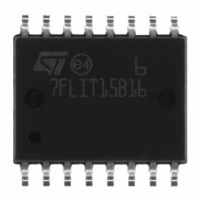ST7FLIT15BY1M6 STMicroelectronics, ST7FLIT15BY1M6 Datasheet - Page 67

ST7FLIT15BY1M6
Manufacturer Part Number
ST7FLIT15BY1M6
Description
IC MCU 8BIT 4K FLASH 16-SOIC
Manufacturer
STMicroelectronics
Series
ST7r
Datasheet
1.ST7FLIT15BY1M6.pdf
(159 pages)
Specifications of ST7FLIT15BY1M6
Core Processor
ST7
Core Size
8-Bit
Speed
8MHz
Connectivity
SPI
Peripherals
LVD, POR, PWM, WDT
Number Of I /o
11
Program Memory Size
4KB (4K x 8)
Program Memory Type
FLASH
Ram Size
256 x 8
Voltage - Supply (vcc/vdd)
2.7 V ~ 5.5 V
Data Converters
A/D 7x10b
Oscillator Type
Internal
Operating Temperature
-40°C ~ 85°C
Package / Case
16-SOIC (0.300", 7.5mm Width)
Controller Family/series
ST7
No. Of I/o's
13
Ram Memory Size
256Byte
Cpu Speed
8MHz
No. Of Timers
5
Rohs Compliant
Yes
Processor Series
ST7FLIT1x
Core
ST7
Data Bus Width
8 bit
Data Ram Size
256 B
Interface Type
SPI
Maximum Clock Frequency
8 MHz
Number Of Programmable I/os
17
Number Of Timers
4
Maximum Operating Temperature
+ 85 C
Mounting Style
SMD/SMT
Development Tools By Supplier
ST7FLITE-SK/RAIS, ST7MDT10-DVP3, ST7MDT10-EMU3, STX-RLINK
Minimum Operating Temperature
- 40 C
On-chip Adc
10 bit, 7 Channel
For Use With
497-5049 - KIT STARTER RAISONANCE ST7FLITE497-5046 - KIT TOOL FOR ST7/UPSD/STR7 MCU
Lead Free Status / RoHS Status
Lead free / RoHS Compliant
Eeprom Size
-
Lead Free Status / Rohs Status
Details
Other names
497-8245-5
ST7FLIT15BY1M6
ST7FLIT15BY1M6
Available stocks
Company
Part Number
Manufacturer
Quantity
Price
DUAL 12-BIT AUTORELOAD TIMER 4 (Cont’d)
11.2.3.6 One Pulse Mode
One Pulse Mode can be used to control PWM2/3
signal with an external LTIC pin. This mode is
available only in dual timer mode i.e. only for
CNTR2, when the OP_EN bit in PWM3CSR regis-
ter is set.
One Pulse Mode is activated by the external LTIC
input. The active edge of the LTIC pin is selected
by the OPEDGE bit in the PWM3CSR register.
After getting the active edge of the LTIC pin,
CNTR2 is reset (000h) and PWM3 is set to high.
CNTR2 starts counting from 000h, when it reaches
the active DCR3 value then the PWM3 output
goes low. Till this time, any further transitions on
the LTIC signal will have no effect. If there are
LTIC transitions after CNTR2 reaches the DCR3
value, CNTR2 is reset again and the PWM3 output
goes high.
If there is no LTIC active edge then CNTR2 will
count till it reaches the ATR2 value, and then it will
be reset again and the PWM3 output is set to high.
The counter again starts counting from 000h,
when it reaches the active DCR3 value the PWM3
output goes low, the counter counts till it reaches
the ATR2 value, it resets and the PWM3 output is
set to high and it goes on the same way.
The same operation applies for the PWM2 output,
but in this case the comparison is done on the
DCR2 value.
The OP_EN and OPEDGE bits take effect on the
fly and are not synchronized with the CNTR2 over-
flow.
The OP2/3 bits can be used to inverse the polarity
of the PWM2/3 outputs in one-pulse mode. The
update of these bits (OP2/3) is synchronized with
the CNTR2 overflow, they will be updated if the
TRAN2 bit is set.
Notes:
1. If CNTR2 is running at 32 MHz, the time taken
from activation of LTIC input and CNTR2 reset is
between 2 and 3 t
(with 8 MHz f
2. The Lite Timer input capture interrupt must be
disabled while 12-bit ARTimer is in One Pulse
Mode. This is to avoid spurious interrupts.
3. The priority of various events affecting PWM3 is
as follows:
– Break (Highest priority)
– One-pulse mode with active LTIC edge
– Forced overflow (by FORCE2 bit)
cpu
).
CNTR2
cycles, i.e. 66 ns to 99 ns
– One-pulse mode without active LTIC edge
– Normal PWM operation. (Lowest priority)
4. It is possible to synchronize the update of
DCR2/3 registers and OP2/3 bits with the CNTR2
reset. This is managed by the overflow interrupt
which is generated if CNTR2 is reset either due to
an ATR match or an active pulse on the LTIC pin.
5. Updating the DCR2/3 registers and OP2/3 bits
in one-pulse mode is done dynamically by soft-
ware using force update (FORCE2 bit in the
ATCSR2 register).
6. DCR3 update in this mode is not synchronized
with any event. Consequently the next PWM3 cy-
cle just after the change may be longer than ex-
pected (refer to
7. In One Pulse Mode the ATR2 value must be
greater than the DCR2/3 value for the PWM2/3
outputs. (contrary to normal PWM mode)
8. If there is an active edge on the LTIC pin after
the CNTR2 has reset due to an ATR2 match, then
the timer gets reset again. The duty cycle may be
modified depending on whether the new DCR val-
ue is less than or more than the previous value.
9. The TRAN2 bit must be set simultaneously with
the FORCE2 bit in the same instruction after a
write to the DCR register.
10. The ATR2 value should be changed after an
overflow in one pulse mode to avoid an irregular
PWM cycle.
11. When exiting from one pulse mode, the
OP_EN bit in the PWM3CSR register must be re-
set first and then the ENCNTR2 bit (if CNTR2 is to
be stopped).
How to Enter One Pulse Mode:
1. Load the ATR2H/ATR2L registers with required
value.
2. Load the DCR3H/DCR3L registers for PWM3
output. The ATR2 value must be greater than
DCR3.
3. Set the OP3 bit in the PWM3CSR register if po-
larity change is required.
4. Start the CNTR2 counter by setting the
ENCNTR2 bit in the ATCSR2 register.
5. Set TRAN2 bit in ATCSR2 to enable transfer.
6. Wait for an overflow event by polling the OVF2
flag in the ATCSR2 register.
7. Select the counter clock using the CK[1:0] bits in
the ATCSR register.
Figure
15).
ST7LITE1xB
67/159
1













